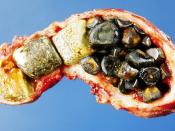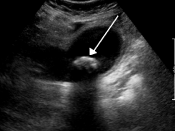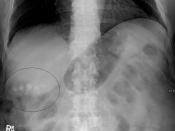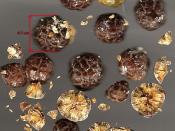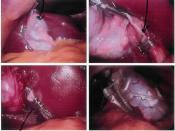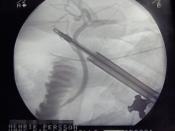GALLSTONES: What Are Gallstones? Gallstones are solid little balls that form in the gall bladder. Gallstones are created when bile substances, cholesterol and bile pigments, mainly,form together and create small odd shaped balls.
The stones which form mainly from cholesterol are called cholesterol stones and account for 80% of stones found in the gall bladder. The other 20% of stones found in the gall bladder are Pigment stones. They are small, dark in color and are made of bilirubin and calcium salts. Factors that contribute to the development of pigment stones include, cirrhosis, biliary tract infections and hereditary blood cell disorders.
Gallstones can be as small as a grain of sand, to as large as a golf ball. Depending on the case, and speed of development, the gall bladder may produce many small stones, thousands, or few, very large stones. Gall stones can also form at any amount in between, but for the most part, the more stones the smaller each one is.
The same goes for the bigger stones.
Who is at Risk? At the rate we are currently at, for people living in the United States, one million will develop gallstones this year alone. Those million will become part of a group of about twenty million Americans, or 10% of our population who already have gallstones in some form.
Not all people will have the same odds to get them as others. Americans who have the highest chance of developing gallstones are: o Native Americans.
o All women between 20-60 years old, women are twice as likely to develop stones than men are.
o Men and Women over 60.
o Pregnant women, who before pregnancy had consumed birth control pills.
o People who lose a lot of weight at once.
o All people that are overweight.
Mexican men and women of all ages.
How do I know if I have them? Most of the million Americans who will develop gallstones this year will not even know it. These stones are probably too small to cause problems. They are usually detected during other checkups and if detected will probably by treated with medicine.
How are they Diagnosed? Gallstones are usually detected during x-rays or ultrasounds, they are usually found by mistake or because of a complaint of abdominal pain.
When looking for gallstone ultrasound is the most common tool because the waves will pinpoint the exact location. Waves are sent into the abdomen to create an image of the gallbladder. If stones are present, then the sound waves will bounce off the stones, revealing them to the doctor.
What can they do to my body? When gallstones begin to cause problems a severe pain will begin in the upper abdomen and last from twenty minutes to several hours. Gallstone problems can also cause back pain and induce nausea and vomiting.
Gallstone attacks can happen weekly, monthly or yearly until the problem is fixed. The odds are very much against an individual to only experience one attack, so after the first attack, a doctor's visit would probably be the best idea.
Gallstones are not secluded to the gallbladder and often flow out of it and into the cystic duct. The cystic duct is the channel through which bile goes to the small intestine. Blockage of the cystic duct is called cholecystis, which leads to the inflammation of the gallbladder. That is a fairly common side effect of gallstones and can be fixed very simply.
A few of the less common and much more serious blockages gallstones can do, are, the blockage of bile ducts between the liver and intestine. The blockage of bile from the gallbladder and liver can cause jaundice and abdominal pain. Gallstones can also block the passage of digestive fluids secreted from the pancreas into the small intestine. That blockage leads to pancreatitis, which inflames the pancreas.
All blockages, if caught early, can be cured without prolonged problem, but a negligence of treatment can lead to extreme damage of the gallbladder, liver or, pancreas. All of which can be deadly. Warning signs for the more serious blockages are fever, jaundice (change of skin color to yellow), and intense abdominal pain.
How Can they be Treated Surgically? There are two main surgeries to completely rid the body of gallstones. The most effective and most used surgery is galled a Cholecystectomy. Each year 500,000 American's undergo a cholecystectomy to remove their gall bladder. A new, up and coming gallstone surgery is laproscopic cholecystectomy. They both serve the same purpose, but the laparoscopic is more technologically advanced and tends to have more side effects.
The standard cholecystectomy is a major abdominal surgery, which results in the doctor removing the gall bladder through a 5-8 inch incision. The hospital recovery time is a week and home recuperation takes several weeks to a month.
The laparoscopic surgery uses a few small incisions and the insertion of a small light and tiny surgical instruments. The light illuminates the human insides along with a small camera, which sends the images into a computer screen above the patient. The doctor guides his tools based on what he sees. When the gall bladder is found it is severed from all surrounding organs and removed through one of the small incisions.
The new technology proves to be better cosmetically and, results in the recuperation time of only a few days. The possibility for damage to the bile ducts or other systems is greater than the standard procedure, so whatever the patient and doctor decide is the safest way to go is normally what happens. However, if a doctor has trouble finding his way around the organs with the tiny tools, normally due to irregularities in the body, than they almost always finish the job with the standard procedure.
The bottom line is, as long as doctors find the gallstone problem quickly, than no matter what surgery, the problem will be fixed.
How can they be treated non-surgically? Instead of surgery many people have now turned to special medicines to cure their gallstones. These medicines can only be used in special situations and mostly to treat stones predominantly made up of cholesterol.
As found on Iafrica.com some of the nutritional treatments to break down gallstones inside the body are: o Increase fibre intake eg. Acidophilus Fibre- 1 dessertspoon per day.
o Avoid carbohydrates and fatty foods.
o Eat regular small meals, 5-6 small meal per day.
o Reduce meat intake and increase intake of fruit, vegetables and, legumes.
o Supplement the diet with lecithin granules, it enhances bile solubilization.
o Check for food sensitivities.
o Drink 2-3 cups of dandelion herb tea regularly.
o Reduce cholesterol by taking Soya protein.
o Reduce weight slowly by following a low fat, sugar, and alcohol diet.
Copper supplementation, 2-3mg/day aids conversion of cholesterol to bile.
HERBAL SUPPLEMENTS: o Chelidonium majus (Greater Celedine) 750 mg/day to stimulate bile excretion o Chionanthus virginicus (Fringe Tree) 750 mg/day (Stimulate gall and liver) o Taraxcum officinale radix (Dandelion Root)1-5 g/day (Stimulate gall and liver secretions) o Cynara scolymus (Globe artichoke) 1.5 g/day (Gall and liver protection)
